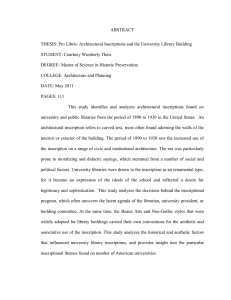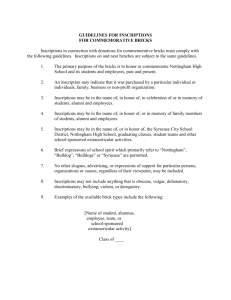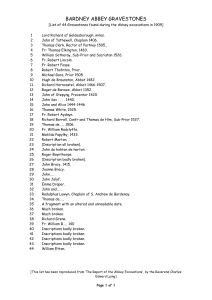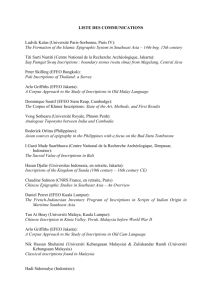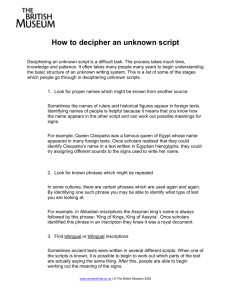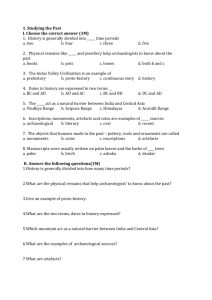3D-SUTRA – INTERACTIVE ANALYSIS TOOL FOR A WEB- ATLAS OF... SUTRA INSCRIPTIONS IN CHINA
advertisement
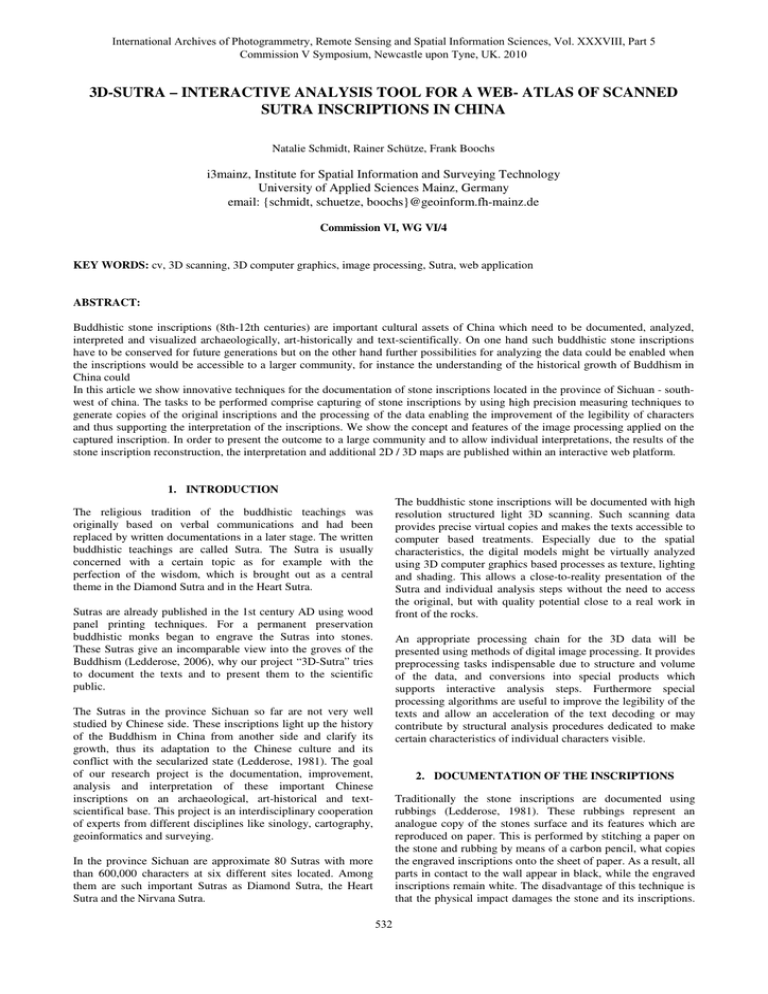
International Archives of Photogrammetry, Remote Sensing and Spatial Information Sciences, Vol. XXXVIII, Part 5
Commission V Symposium, Newcastle upon Tyne, UK. 2010
3D-SUTRA – INTERACTIVE ANALYSIS TOOL FOR A WEB- ATLAS OF SCANNED
SUTRA INSCRIPTIONS IN CHINA
Natalie Schmidt, Rainer Schütze, Frank Boochs
i3mainz, Institute for Spatial Information and Surveying Technology
University of Applied Sciences Mainz, Germany
email: {schmidt, schuetze, boochs}@geoinform.fh-mainz.de
Commission VI, WG VI/4
KEY WORDS: cv, 3D scanning, 3D computer graphics, image processing, Sutra, web application
ABSTRACT:
Buddhistic stone inscriptions (8th-12th centuries) are important cultural assets of China which need to be documented, analyzed,
interpreted and visualized archaeologically, art-historically and text-scientifically. On one hand such buddhistic stone inscriptions
have to be conserved for future generations but on the other hand further possibilities for analyzing the data could be enabled when
the inscriptions would be accessible to a larger community, for instance the understanding of the historical growth of Buddhism in
China could
In this article we show innovative techniques for the documentation of stone inscriptions located in the province of Sichuan - southwest of china. The tasks to be performed comprise capturing of stone inscriptions by using high precision measuring techniques to
generate copies of the original inscriptions and the processing of the data enabling the improvement of the legibility of characters
and thus supporting the interpretation of the inscriptions. We show the concept and features of the image processing applied on the
captured inscription. In order to present the outcome to a large community and to allow individual interpretations, the results of the
stone inscription reconstruction, the interpretation and additional 2D / 3D maps are published within an interactive web platform.
1. INTRODUCTION
The buddhistic stone inscriptions will be documented with high
resolution structured light 3D scanning. Such scanning data
provides precise virtual copies and makes the texts accessible to
computer based treatments. Especially due to the spatial
characteristics, the digital models might be virtually analyzed
using 3D computer graphics based processes as texture, lighting
and shading. This allows a close-to-reality presentation of the
Sutra and individual analysis steps without the need to access
the original, but with quality potential close to a real work in
front of the rocks.
The religious tradition of the buddhistic teachings was
originally based on verbal communications and had been
replaced by written documentations in a later stage. The written
buddhistic teachings are called Sutra. The Sutra is usually
concerned with a certain topic as for example with the
perfection of the wisdom, which is brought out as a central
theme in the Diamond Sutra and in the Heart Sutra.
Sutras are already published in the 1st century AD using wood
panel printing techniques. For a permanent preservation
buddhistic monks began to engrave the Sutras into stones.
These Sutras give an incomparable view into the groves of the
Buddhism (Ledderose, 2006), why our project “3D-Sutra” tries
to document the texts and to present them to the scientific
public.
An appropriate processing chain for the 3D data will be
presented using methods of digital image processing. It provides
preprocessing tasks indispensable due to structure and volume
of the data, and conversions into special products which
supports interactive analysis steps. Furthermore special
processing algorithms are useful to improve the legibility of the
texts and allow an acceleration of the text decoding or may
contribute by structural analysis procedures dedicated to make
certain characteristics of individual characters visible.
The Sutras in the province Sichuan so far are not very well
studied by Chinese side. These inscriptions light up the history
of the Buddhism in China from another side and clarify its
growth, thus its adaptation to the Chinese culture and its
conflict with the secularized state (Ledderose, 1981). The goal
of our research project is the documentation, improvement,
analysis and interpretation of these important Chinese
inscriptions on an archaeological, art-historical and textscientifical base. This project is an interdisciplinary cooperation
of experts from different disciplines like sinology, cartography,
geoinformatics and surveying.
2. DOCUMENTATION OF THE INSCRIPTIONS
Traditionally the stone inscriptions are documented using
rubbings (Ledderose, 1981). These rubbings represent an
analogue copy of the stones surface and its features which are
reproduced on paper. This is performed by stitching a paper on
the stone and rubbing by means of a carbon pencil, what copies
the engraved inscriptions onto the sheet of paper. As a result, all
parts in contact to the wall appear in black, while the engraved
inscriptions remain white. The disadvantage of this technique is
that the physical impact damages the stone and its inscriptions.
In the province Sichuan are approximate 80 Sutras with more
than 600,000 characters at six different sites located. Among
them are such important Sutras as Diamond Sutra, the Heart
Sutra and the Nirvana Sutra.
532
International Archives of Photogrammetry, Remote Sensing and Spatial Information Sciences, Vol. XXXVIII, Part 5
Commission V Symposium, Newcastle upon Tyne, UK. 2010
Figure 1. 3D model of the topography
and offer to model the spatial and regional context of the
different Sutras among each other. That’s why it is of general
value to use various measuring techniques in the field in order
to optimize the framework for the documentation and analysis
of art-historical objects (Boochs et al. 2006).
Present-day measuring technique for local and regional
investigations is Terrestrial Laserscanning. It is used to capture
the 3D geometry of the environment around the inscriptions.
The resulting 3D pointcloud documents the topography so that
the relative position of the inscriptions on each other can be
expressed. Based on the point clouds a precise 3D model can be
created (e.g. Figure 1), which is used to analyze the spatial
relationships of the Sutra sites and also allows to visualize the
objects in a virtually environment.
These problems will be avoided by non-contact 3D-measuring
techniques, like fringe projection, for example. But the
advantages of modern 3D techniques are not limited to an
objective documentation capability. Simple changes of the
equipment may change scale and resolution comparably and
allow further documentation approaches. So, precise detailed
models might be complemented by local and regional models
permitting further analysis processes and spatial considerations
thus extending the potential for art-historian research.
For high resolution scans a fringe projecting system can be used
allowing the capture of 3D geometries in size of less than 1 m³.
It offers a close-to-detail 3D pointcloud of the inscriptions
(Böhler et al. 2004). This provides more possibilities in
processing and supports the interpretation by different methods
of 3D visualization (Hanke, Böhler 2004) as shown in Figure 3.
The buddhistic stone inscriptions which have an extension of up
to 3x4 m are scanned with a lateral resolution in the order of
0.25 mm. The Sutra characters are round about 1 cm².
Figure 2. Comparison of rubbing (left) and processed results of
the fringe projection (right)
With respect to the high resolution 3D technique the data
collection provides an exact geometrical copy of the original
inscription offering better results in legibility of each character
compared to the traditional rubbing (see Figure 2). Moreover it
gives a more objective base for analysis and has less impact
onto the sometimes sensitive and eroded surfaces. Furthermore
the 3D data of the Sutras allows more and other possibilities in
processing and gives better preconditions for the interpretation.
In regard of the local context, geometrical relations between
inscriptions or parts thereof may simplify their interpretation
Figure 3. 3D model of the inscriptions
In addition to Laserscanning and structured-light 3D scanning
we used Polynomial Texture Mapping (PTM), Stereo
Photogrammetry and Panoramic Photography for the
documentation of the inscriptions and their environment. They
represent an alternative with different information content and
533
International Archives of Photogrammetry, Remote Sensing and Spatial Information Sciences, Vol. XXXVIII, Part 5
Commission V Symposium, Newcastle upon Tyne, UK. 2010
use (Hoffmann et al. 2006). These techniques can be an
alternative if an object is not reachable with the high-tech
equipment e.g. the Terrestrial Laserscanner or structured-light
scanner. In that case Stereo Photogrammetry offers good visual
information and a precise basis for measuring, but needs good
contrast for optimal results. This might not be the case for
damaged and eroded characters .Also, the spatial information is
only implicitly included, why it might be necessary to apply
manual or automatically post processing when the spatial
information of the character is explicitly needed.
principle, this corresponds to a transformation of the complex
3D data into a 2½D space. Based on the 2½D data we can apply
common image processing tools and generate a raster based
model, called Digital Elevation Mode (DEM), without having a
substantial information loss. The possibility to use procedures
from digital image processing furthermore simplifies following
steps and avoids the handling of a complex vector based 3D
model. Furthermore we are able to reduce the volume of raster
data by a factor 100 (4.3GByte to 40MByte) which is
impossible to be achieved by other compression strategies.
Polynomial Texture Mapping (PTM) mainly provides a plastic
visualization which is used for the manual interpretation
(Malzbender et al. 2010). PTM is used for displaying an object
under various lighting direction. The PTM is created by
photographing an object multiple times with various lighting
directions. These PTMs provides a deeper look onto each
character which supports the interpretation of the inscription in
an additional way. However, this kind of data is only twodimensional.
3.2 Data Preparation
The reduction of the data volume achieved by transforming the
3D spatial data in 2½D raster data (DEM) leads to insufficient
legibility of the characters (see Figure 4). This is based on the
fact that the walls surfaces show strong spatial variations. Thus
the characters are represented by less information so that the
influence of the walls surface has to be reduced.
3. PROCESSING
The original 3D data sets represent a large data volume. An
effective use of these data can only be realized if they are
condensed and prepared in an adequate way. This means the
reduction of the data volume, minimizing disturbing influences
and emphasizing relevant information. The preparation of the
data should offer a good base for a manual interpretation
performed by the sinologist and also serve as base for an
automated interpretation achieved by algorithms like template
matching (Steinke 2009). On the other hand the data should be
prepared for a performant presentation to a wider community
via internet.
3.1 Handling the Amount of Data
Due to the high resolution – the texts will be represented by
spatial elements of some microns in size - areas of some square
meter will generate millions of spatial elements, which have to
be handled and processed. Thus it is essential to have a closer
look into aspects of data reduction and / or efficient data
handling. Therefore additional processes have been applied
allowing reducing the data volume, to minimize interfering
influences as well as to enhance the relevant information.
We distinguish three main image processing steps to increase
the legibility of the characters especially the damaged ones.
These process steps are the transformation from the absolute
heights to relative heights, the elimination of the surface
topography and a further reduction of the data set.
As additional aspect, the size of the data has to be checked with
respect to the needs of a web based publication. A native 3D
model of an inscription of 2x2 m2 may result in a data volume
of ~4.32 GByte, when a spatial resolution of 0.25mm will be
used. This amount of data cannot be transferred over the
internet in an acceptable manner. The data volume has to be
reduced considerably before it might be transferred to the client
in a common rate.
By the unevenness of the walls and sometimes existing fractures
in the walls large differences in height are present. Most
imaging applications are just able to handle 8bit per image
channel. This leads in the raster based DEM to the fact that the
substantial information of the engraved characters on the walls
are not recognizable. For this reason an image normalization
algorithm is accomplished, whereby a smoothed variant of the
raster-based DEM is subtracted from the original.
As conventional compression algorithms result in a loss of
information, more intelligent strategies are necessary. In this
context only the individual letters are important for us. As the
spatial characteristics of the rock itself has many times higher
variations than the texts themselves only special approaches
lead to considerable improvements (Schmidt 2009): The spatial
background information has to be eliminated leaving only
spatial variations for each individual element of the inscription.
This will be achieved by planes fitted into the model and the
projection of the original 3D points onto this reference plane. In
A very important part of this step is the filtering algorithm used
for the smoothing operation. The intention of the smoothing
operation is to get a model of the wall within all its
characteristics but without the engraved character. Thus it
separates the characters from the wall by subtracting the
original and smoothed images. The properties of the filtering
algorithm are clearly defined. The type of the filter is a low-pass
filter with a small size so that it filters the image in a local way.
Furthermore it has to be applied several times to even all
characters the weathered one as well as the well-preserved one.
Figure 4. 2½D raster data (DEM)
534
International Archives of Photogrammetry, Remote Sensing and Spatial Information Sciences, Vol. XXXVIII, Part 5
Commission V Symposium, Newcastle upon Tyne, UK. 2010
the characters are emphasized, the well received and the
weathered ones.
In different analysis it clarifies that the size and number of
appliances which provides best results is a low-pass filter with
size 11x11 pixel and number of appliance of 6 (cp. Figure 5 and
Figure 6). The high number of appliances (in our case 6) can
also be replaced by using a large combined filter and applying it
once. However the combined filter is not used because the other
proceeding is less complicated to create and implement. These
properties conduce to highly smoothed characters and less
smoothed sites of fracture.
Figure 5. 3x3 filter applied
two times
Finally by a histogram stretching it is reached that the extracted
height range of the raster-based DEM is transferred on the grey
value range of an 8-bit and/or 16 bit image (see Figure 7). This
process step allows a reduction of the data volume and the color
depth.
The implementation of the histogram stretching is based on the
standard function for transferring grey values. By using the
minimal and maximal grey value of the image all grey value are
stretched to the required range of grey values from 0 to 255 / 0
to 65536. This conduces to the fact that differences in height
less than 1 mm can be differentiated and so the characters itself
are rich in contrast. The general problem resulting is that not
only the well-preserved and the weathered characters are
emphasized but also the roughness of the walls surface. Because
of their differences in height which contain the same range in
the weathered characters and the roughness of the walls surface
these characters can barely be differentiated.
Figure 6. 11x11 filter applied
six times
By subtracting both images, the original and the smoothed one,
the heights are transferred on the basis of absolute heights
related to the local coordinate system of the cave into relative
heights related to the smoothed raster based DEM. Thus it is
reached that mainly the small differences in height are left
which contains the well-preserved and weathered characters as
well as the roughness of the surface. Caused by the bad
handling of boundary pixels in the smoothing operation some
large differences in height still exist but without containing any
substantial information. As an intermediate result the
improvement of the legibility of the characters can be
emphasized, but at this point a huge amount of gray scale values
got lost for displaying irrelevant information.
This fact requires the second processing step. With the help of a
histogram clamping the engraved characters are extracted as
relevant information whereas the difference in height of the wall
is limited. This limitation of the height range goes back on limit
values, which are defined by means of statistic values.
Figure 7. Processed DEM
Defining the limits of the second processing step influences the
appearance of the image and therefore the legibility of the
characters. Thus the tasks are to define the extent or the
placement of the substantial information in the histogram of the
images so that an extraction of the characters is enabled. The
analysis of the histogram and statistics of the images leads to a
definition of the limits based on statistic values, because of
adapting best to the properties and characteristics of each
image. The standard deviation is an appropriate value to define
the limits but it separates a range of height still being to large.
By reducing the standard deviation to a fraction a range of
height can be defined representing only the relevant
information. This conduces to an upper limit accepting a value
of plus an eighth of the standard deviation and a lower limit
receiving a value of minus an eighth of the standard deviation.
However the processing steps provide an enormous increase of
the legibility of the characters and a good base for the manual
and automated interpretation and for the visualization of the
data via internet. Because of the data structure and the quality of
data a further processing can be accomplished using simple
image processing libraries for implementing the algorithms for
automated interpretation and for realizing the planned web
application.
4. MATCHING
The interpretation of the inscription is the main task of the
sinologists. Up to now the interpretation of the inscription is a
manual process which is divided in reading, translating and
extracting the information of each character like size and
position in the documented inscription. According to the mass
of inscriptions (approx. 80) and characters (approx. 600,000)
this procedure is unsuitable in our project. That leads to the fact
that the interpretation should be done more automatically. This
can be realized with template matching that is applied on results
of the previous data processing (see section 3). The resulting
images contain no perspective deformations and are rich in
contrast.
The application of these defined limit values reduces the
complete height differences to a representation of the characters
and the surface of the wall. All heights lower and higher than
the limits are replaced by the limits itself so that these areas in
the raster based DEM are flattened. The raster based DEM is
limited to a difference in height from before approx. 100 cm to
now approx. 3 cm. Thereby the influences resulted from
subtracting the original and smoothed image are minimized and
535
International Archives of Photogrammetry, Remote Sensing and Spatial Information Sciences, Vol. XXXVIII, Part 5
Commission V Symposium, Newcastle upon Tyne, UK. 2010
character and grouping them into different classes it could be
possible to identify different authors or different techniques of
the manufacturer (see Figure 9). Furthermore the template
matching provides mass processing of the interpretation and
simplifies the pre-processing in the interpretation.
5. WEBAPPLICATION
As the final goal of the project is to present the Sutra texts to a
large community using modern means of the internet we want to
show the general concept of the web application together with a
view into individual elements of the solution. In the web
application the general information of the Sutra sites are
accessible for the user. Additionally we integrated 2D & 3D
GIS (Zipf 2007) techniques for presentation and analysis. In
order to give a closer look to the connection of the Sutra texts
they are linked with virtual 3D Sutra and GIS. In the following
we present different visualization concepts allowing supporting
the end user during his process of interpretation and
understanding of the inscriptions.
The results of the documented Sutra texts and already achieved
interpretations of different buddhistic inscriptions are made
accessible over the internet by means of a web portal and serve
as a flexible tool for the sinologist. The web application (see
Figure 10) is designed to show the virtual copy of the
inscription and the results of its interpretation. The user can
inspect the virtual copies of whole inscription boards - we call it
the 3D Sutra - using web based techniques for 3D computer
graphics procedures. These allow manipulations of parameters
like texture, lighting and shading and are designed to give a
close-to-reality presentation of the Sutra. Individual
modifications are possible to improve the subjective impression
by the user trying to support him in his process of
interpretation. Examples are interactive changes of the light
source, directly affecting the shading of the surface and
providing a better idea of the 3D surface of the Sutra. Using
dynamic virtual water filling, the user is able to get an even
better impression on the depth of the characters.
Figure 8. Automatic character extraction using template
matching (e.g. for the character , “no”)
The benefit of the template matching during the interpretation
process is the identification of each character in the whole
inscription based on a digital text reference. The digital
reference the so called taisho contains all Sutra texts in a digital
form and can be requested via internet. In a first step, the
matching locates individual characters, which then will be
searched in the text reference. A comparably small number of
connected letters already defines unique text passages, which
then can definitely be found in the reference. The idea of this
processing is to merge the power of matching algorithm applied
to well-preserved characters with the knowledge contained in
the reference library taisho. The matching might be based on
natural templates extracted from the processed data or onto
generic templates provided by Unicode characters defined in the
Chinese alphabet (see Figure 8).
Figure 10. Web application
In addition to the above mentioned visualization aspect, the web
application shows the user the available interpretations of the
inscriptions. This simplifies an understanding for not
experienced user or provides the experts with an alternative
version of interpretation. Technically this is performed by an
interactive overlay of the digital copy with an interpreted text of
the 3D Sutra. The overlaying information is generated out of the
matching algorithm and is linked between the text and the 3D
character in the Digital Elevation Mode (DEM) automatically.
Figure 9. Group of extracted characters using template matching
for the Buddha ( ) character; Top: DEM image. Bottom:
shaded model
Additional potential for the template matching might result from
a support for further interpretation processes, concerned with
the calligraphy. By extracting structural elements of each
536
International Archives of Photogrammetry, Remote Sensing and Spatial Information Sciences, Vol. XXXVIII, Part 5
Commission V Symposium, Newcastle upon Tyne, UK. 2010
Language and Culture. Edited by Christoph Anderl and Halvor
Eifring. Oslo, Norway, Hermes Publishing, pp. 319-329.
6. CONCLUSION
Modern precision measuring techniques open up new
perspectives for archeological and art-historical questions. This
assumes that the objects are accessible for the equipment and
can be captured with high precision. The captured data opens
up various processing chains and enables the presentation on
the internet, whereby important cultural treasures are made
accessible to a wider community.
Schmidt, N., 2009.
3D-Sutren - Konzeptionierung und
Entwicklung
eines
Prozessierungsmoduls
und
einer
Webapplikation für den Anwendungsbereich Sinologie. In:
Unpublished.
Steinke, K.-H., 2009. Lokalisierung von Schrift in komplexer
Umgebung. In: Tagungsband der Jahrestagung der deutschen
Gesellschaft für Photogrammetrie, Jena, Germany, pp. 165173.
For the stone inscriptions we used fringe projection technique
to document the inscriptions and laser scanning for their
environment. Compared to the traditional rubbing the high
resolution scanner allows us to create a nondestructive virtual
copy of the stone inscription. The digital copies of the original
inscriptions offer better results in legibility of each character as
has been shown in section 2.
Malzbender, T., Gelb, D., Wolters, H., 2001. Polynomial
texture maps. In Computer Graphics, SIGGRAPH 2001
Proceedings, 519–528.
Zipf, A., J. Basanow, P. Neis, S. Neubauer, A. Schilling, 2007.
Towards 3D Spatial Data Infrastructures (3D-SDI) based on
Open Standards - experiences, results and future issues. 3D
GeoInfo07. Int. Workshop on 3D Geo-Information. Delft
However this high resolution measuring techniques produce
huge data sets which cannot be handled by the user who
interprets the Sutras directly neither can it be transferred over
the internet without further processing. Therefore we have
shown in section 3 a process chain in order to prepare the data
for the interpretation and also for the visualization on the
internet. In spite of the good result achieved with the processing
for the interpretation there is a need for an algorithm separating
the weathered characters from the walls surface and emphasize
them.
8. ACKNOWLEDGEMENTS
This work is funded by the “Bundesministerium für Bildung
und Forschung” (BMBF)” – Germany within the “Wechselwirkungen zwischen Natur- und Geisteswissenschaften”
research activity program 01UA0814, what is highly
appreciated by the authors.
We presented an approach (see section 4), for automated
indexing of the Sutras, which may replace the current manual
procedure of indexing the individual characters. With the
presentation on the internet sinologists are capable to work with
the Sutras and to have an in depth look at the 3D characters
from any place of the world like being on site in China.
7. REFERENCES
Boochs, F., Heinz, G., Huxhagen, U., Müller, H., 2006. Digital
Documentation Cultural Heritage Objects using hybrid
recording techniques, CIPA, Zypern, Greece.
Böhler, W., Bordas Vicent, M., Heinz, G., Marbs, A., Müller,
H., 2004. High Quality Scanning and Modeling of Monuments
and Artifacts - Proceedings of the FIG Working Week 2004,
May 22-27 - Athens, Greece. Published by FIG.
Hanke, K., Böhler, W., 2004. Recording and Visualizing the
Cenotaph of German Emperor Maximilian I. Int. Archives of
Photogrammetry & Remote Sensing Vol. XXXV, B5.
Hoffmann, A., Huxhagen, U., Welter, D., Boochs, F., 2006.
Digital reconstruction archaeological objects using hybrid
sensing techniques - the example Porta Nigra. 2nd International
Conference on Remote Sensing Archaeology, Rome, Italy.
Ledderose, L., 1981. Rubbings in Art History. In: Catalogue of
Chinese Rubbings from Field Museum. (Fieldiana
Anthropology New Series, 3). Edited by Hartmut Walravens.
Field Museum of Natural History, Chicago, USA, pp. XXVIIIXXXVI.
Ledderose, L., 2006. The Stones resembled printing blocks. The
engraved Buddhist stone scriptures at Yúnjū monastery of
Fāngshan and the Qìdān canon. In: Studies in Chinese
537
